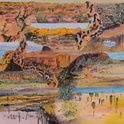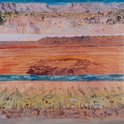John Hurrell – 21 May, 2012
Tuck uses stacked strips in which are placed gulches or chasms, or slivers of sky that musically chop into the tightly structured, parallel divisions of the stretcher. Despite the rendered deserts and mountain ranges, there is an overwhelming sense of careful geometry, usually five or six bands - a hint of Agnes Martin or seventies Don Driver even.
A regular exhibiter at Anna Miles, Barbara Tuck is well known for her wildly imaginative treatment of landscape, space and vegetation, blended with a sensual and playful manipulation of paint. This show is not as vertiginous as some earlier ones, for she is now presenting horizontal bands of what seems to be Australian landscape. They’re arranged like geological strata or layers of a cake, a method also explored decades ago by McCahon in Nelson and Angus in Otago.
With McCahon there was a comic strip format of black-lined horizontal frames, while with Angus two landscapes (one positioned over the other - no sky in between) were seamlessly blended into one. Tuck on the other hand uses stacked strips in which are placed gulches or chasms, or slivers of sky that musically chop into the tightly structured, parallel divisions of the stretcher. Despite the rendered deserts and mountain ranges, there is an overwhelming sense of careful geometry, usually five or six bands - a hint of Agnes Martin or seventies Don Driver even. Though you are looking through representations of the dry Australian air and stunted shrub life, you are even more conscious of looking at the picture plane and hot sumptuous - thinly applied - oil paint.
These are grid paintings of sorts, for your eye caresses the piled up edges supporting multiple receding horizons - and then flips over to appraise the ripples of lined up small valleys clambering up the sides of pink mountain ranges. Some are organic, with sticky slugs of patterned Twombly-like growths descending the canvas and disrupting the order. Others emphasise tongue or t- shaped negative forms that interact with splodgy, stick-packed cave mouths and stringy bush clusters. Others still feature circular mountain ranges disguised as moonlike craters on flat slabbed deserts. No signs of animal life or human habitation anywhere.
Despite the heaped planar recessions that are like a dresser with its drawers removed, the sheer density of painterly detail makes you linger over each canvas’s patina. You look towards distant blue hills and shapely bright skies while aware of the manually worked surface as a skin.
Tuck obviously relishes the occasional lyrical flurry of repeated forms, trees mimicking bulbous rocks, split open riverbeds copying gouged, eroded cliff edges - like a Walters painting with patterns alternating from side to side. It is even possible to forget that these are imaginary landscapes - to enjoy the compositional structure and shape placement (mixed with pockets of wildly improvised flourishing) entirely for their own sake, without evocation of ‘place’ or wonderment at permutations of rock. You could turn them upside down and still enjoy them. Yet right way up these paintings cover a lot of bases - they could be a geologist’s or botanist’s inventory, or listing invisible indiginous communities as well. Packed with nonvisual layerings.
John Hurrell






 Advertising in this column
Advertising in this column Two Rooms presents a program of residencies and projects
Two Rooms presents a program of residencies and projects



This Discussion has 0 comments.
Comment
Participate
Register to Participate.
Sign in
Sign in to an existing account.